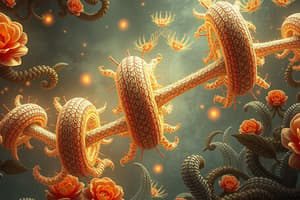Podcast
Questions and Answers
Summarize the three stages of transcription.
Summarize the three stages of transcription.
Initiation, Elongation, and Termination. Initiation is when RNA binds to the beginning of the gene. Elongation is when the nucleotides are added and the RNA chain elongates. Termination is when the stop codon terminates it.
What is Rifamycin B?
What is Rifamycin B?
Rifamycin B selectively binds to the bacterial RNA polymerase and inhibits transcription initiation.
What is Actinomycin B?
What is Actinomycin B?
Actinomycin B non-selectively binds to DNA and inhibits transcription elongation.
What are the six types of RNA found in a cell?
What are the six types of RNA found in a cell?
Draw/diagram a ribosome structure detailing the two subunits of the ribosome and the three binding sites for tRNA.
Draw/diagram a ribosome structure detailing the two subunits of the ribosome and the three binding sites for tRNA.
Summarize the three stages of protein synthesis.
Summarize the three stages of protein synthesis.
What is Streptomycin?
What is Streptomycin?
What is Erythromycin?
What is Erythromycin?
How can transcription and translation happen simultaneously in a bacterial cell?
How can transcription and translation happen simultaneously in a bacterial cell?
Explain the role of chaperones in protein folding.
Explain the role of chaperones in protein folding.
Explain the purpose of DNA annotation and how it is used in bioinformatics.
Explain the purpose of DNA annotation and how it is used in bioinformatics.
Flashcards are hidden until you start studying
Study Notes
Stages of Transcription
- Transcription comprises three stages: Initiation, Elongation, and Termination.
- Initiation: RNA polymerase binds to the beginning of a gene.
- Elongation: Nucleotides are added, elongating the RNA chain.
- Termination: A stop codon signals the end of transcription.
Rifamycin B
- Selectively inhibits transcription initiation by binding to bacterial RNA polymerase.
Actinomycin B
- Non-selectively binds to DNA, affecting both eukaryotic and prokaryotic cells.
- Inhibits the elongation phase of transcription.
Types of RNA
- Six types of RNA in a cell include:
- Messenger RNA (mRNA)
- Ribosomal RNA (rRNA)
- Transfer RNA (tRNA)
- Small RNA (sRNA)
- tmRNA
- Catalytic RNA (cRNA)
Ribosome Structure
- Ribosomes consist of two subunits containing rRNA and proteins.
- Prokaryotic ribosomes have 30S and 50S subunits, forming a 70S ribosome.
- The 70S ribosome features three tRNA binding sites:
- A (Accepting): Binds incoming aminoacyl tRNA.
- P (Peptidyl): Holds tRNA with the growing polypeptide chain.
- E (Exit): Binds tRNA recently stripped of its polypeptide.
Stages of Protein Synthesis
- Initiation: The first amino acid is positioned as two ribosomal subunits come together.
- Elongation: Amino acids are sequentially added based on mRNA instructions.
- Termination: Releases the completed protein and recycles ribosomal subunits.
- Each stage requires specific protein factors and energy (GTP).
Streptomycin
- Inhibits 70S ribosome formation by preventing 30S and 50S subunits from joining.
- Resistance can occur through mutation of the S12 gene, allowing ribosome function without streptomycin binding.
Erythromycin
- Similar to streptomycin, it prevents the formation of the 70S ribosome.
- Resistance mechanisms are analogous, involving the S12 gene mutation.
Coupled Transcription and Translation in Bacteria
- Bacterial cells can initiate translation while transcription is still in progress.
- Multiple ribosomes can attach to a polycistronic mRNA molecule simultaneously.
- This process is termed coupled transcription and translation, contrasting with eukaryotic cells that separate these processes into different compartments.
Role of Chaperones in Protein Folding
- Chaperones assist in the folding of many proteins.
- Examples include:
- GroEL and GroES: Form stacked rings with a hollow center for polypeptide fitting.
- DnaK: Binds directly to polypeptides without forming rings, aiding in proper folding.
Purpose of DNA Annotation in Bioinformatics
- DNA annotation identifies the functional meaning of DNA sequences.
- Involves pattern recognition by computers, focusing on regulatory sequences, open-reading frames (ORFs), and rDNA/tRNA genes.
- ORFs are crucial as they encode actual polypeptides.
- In eukaryotes, ORF identification is complicated by introns present in the gene structure.
Studying That Suits You
Use AI to generate personalized quizzes and flashcards to suit your learning preferences.




